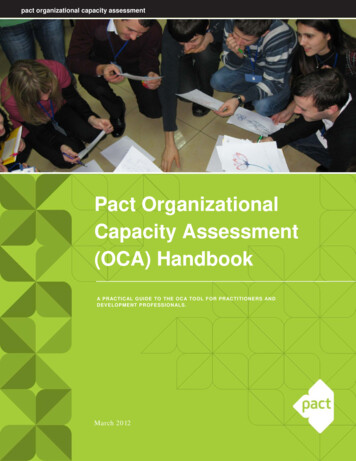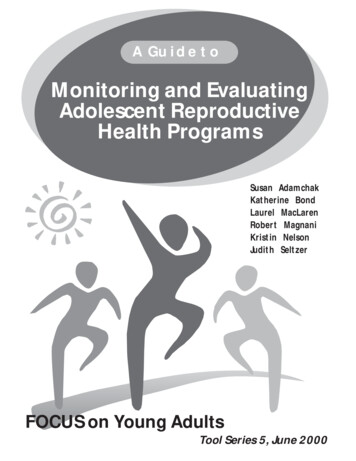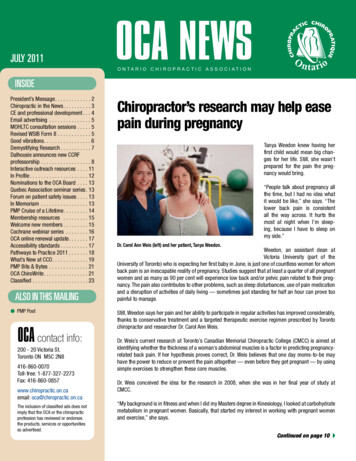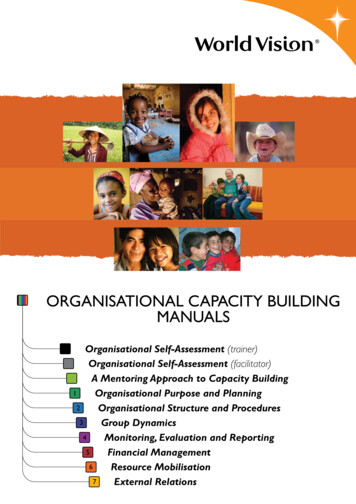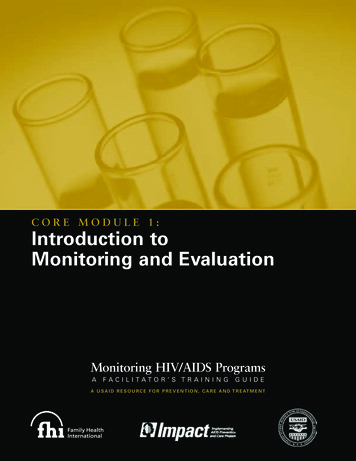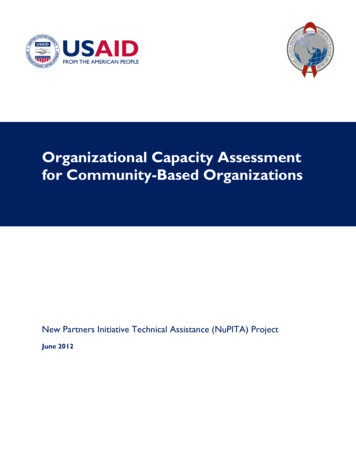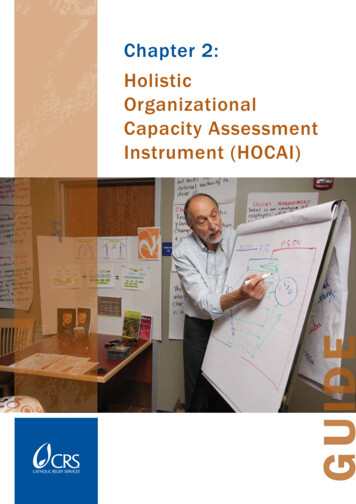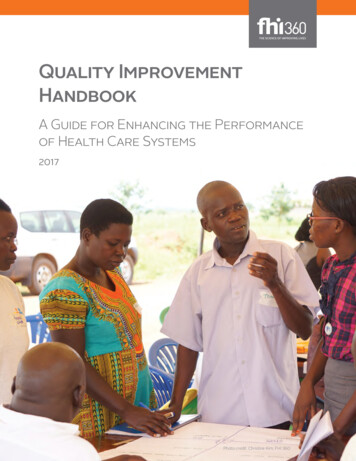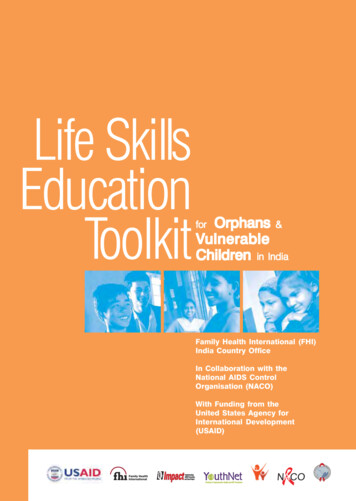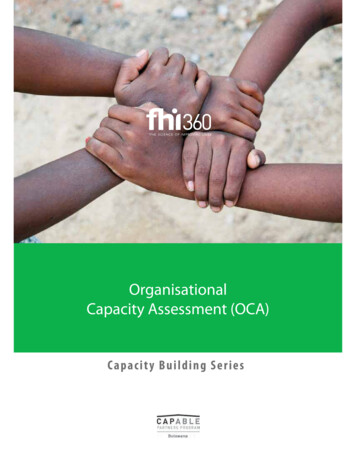
Transcription
OrganisationalCapacity Assessment (OCA)Capacity Building Series
FHI 360FHI 360 is a global development organisation with a rigorous, evidence-basedapproach. Our professional staff includes experts in health, nutrition, education,economic development, civil society, environment and research. FHI 360operates from 60 offices with 4,400 staff in the United States and around theworld.We have worked with 1,400 partners in 125 countries, forging strongrelationships with governments, diverse organisations, the private sectorand communities. Our commitment to partnerships at every level and ourmultidisciplinary approach enable us to have a lasting impact on the individuals,communities and countries we serve–improving lives for millions.Capable Partners (CAP) projectCapable Partners is a USAID-funded project that supports the Botswanagovernment’s efforts to mitigate HIV. The CAP project promotes organisationaldevelopment and capacity building through networking and technical support.CAP partners with non-governmental organisations (NGOs), faith-basedorganisations (FBOs) and community-based organisations (CBOs) on HIVprevention services under the U.S. President’s Emergency Plan for AIDS Relief(PEPFAR) and Peace Corps engagement in PEPFAR programmes.The CAP project also supports monitoring and evaluation of grantees andsub-grantees, routine training on HIV prevention interventions, and thedevelopment and dissemination of behaviour change tools. Strengtheningcommunities towards sustainability is the over-riding goal of the CAP project.
Organisational Capacity Assessment (OCA)ForewordThis publication is part of a Capacity Building Series documenting the experiences of the Capable Partners Botswanaproject in organisational development, and building the technical capacity of local civil society organisations in HIVPrevention, from 2008-2011.It is widely recognised that a strong civil society is essential for a successful and sustained response to the HIV andAIDS epidemic in Botswana. Much debate has taken place around the limited capacity of civil society in Botswana,and to date there have been only a few success stories. We are therefore pleased to introduce you to this Capacity Building Series which features real life experiences of civil society organisations in Botswana actively participating in theirown capacity enhancement, and forging stronger and more effective organisations as a result. While the CapablePartners Botswana project contributed a solid capacity building model together with expert facilitation and tools,we believe it is the enthusiastic participation and ownership of the process by our local partners, which has been themost important ingredient for success.As we look beyond the end of this project, we thank USAID for the opportunity to contribute to civil society strengthening in Botswana. We wish our partners and other civil society organisations every success in achieving their mandates, and hope this and other publications in the Capacity Building Series will prove useful in strengthening organisations, and, by doing so, improve the quality and sustainability of the response to the HIV and AIDS epidemic. Severalindividuals and institutions have contributed to the case studies, guidance and tools outlined in this and other documents in the series. We thank all involved for their commitment and insights.Mike Merrigan, Dr. PHChief of PartyFHI Development 360 BotswanaThis Guideline has been made possible by the generous supportof the American people through the United States Agency forInternational Development (USAID).FHI has acquired the programmemes, expertise, and assets ofAED.Visit us at www.fhi360.org1
Organisational Capacity Assessment (OCA)2
Organisational Capacity Assessment ACAPCBOCSODQAEFBFBOFHI RSAHA-UBTATLWUNAIDSUNDPUSAIDUSGYWFCAcquired ImmunodeÀciency SyndromeAfrican Methodist Episcopal Services TrustBotswana AIDS Impact SurveyBotswana Business Coalition against HIV and AIDSBehaviour Change CommunicationBotswana National HIV and AIDS Prevention SupportBotswana Christian AIDS Intervention ProgrammemeBotswana Network of People Living with HIV and AIDSCapable PartnersCommunity-Based OrganisationCivil Society OrganisationData Quality AuditsEvangelical Fellowship of BotswanaFaith-Based OrganisationFamily Health International 360Government of BotswanaHuman ImmunodeÀciency VirusHumana People to PeopleHuman ResourcesInformation Education and CommunicationMonitoring and EvaluationMultiple and Concurrent Sexual PartnershipsMinistry of HealthNational AIDS Coordination AgencyNongovernmental OrganisationNational Strategic Framework for HIV and AIDSOrganisational Capacity AssessmentOrganisational DevelopmentPeople Living with HIV and AIDSPresident’s Emergency Plan for AIDS ReliefStudents against HIV and AIDS–University of BotswanaTechnical AssistanceTrue Love WaitsJoint United Nations Programmeme on HIV and AIDSUnited National Development ProgrammemeUnited States Agency for International DevelopmentUnited States GovernmentYoung Women’s Friendly Centre3
Organisational Capacity Assessment (OCA)4
Organisational Capacity Assessment (OCA)Table of ContentsBackground And Introduction7What is Capacity and Why Is It Importantfor the Sustainability of HIV and AIDSPrevention Responses?8Conceptual Framework for ImprovingOrganisational Capacity in HIV Prevention9Capacity Assessments in Health andHIV and AIDS programmes10CAP Botswana’s Organisational CapacityBuilding Approach11CAP Botswana’s Capacity AssessmentDomains12CAP Botswana’s Capacity AssessmentProcess15Evolution of the OCA between baselineand mid-point16Scoring Structure of the OCA Tool17TA Prioritisation Exercise19Technical Assistance Plan20Results21Improved capacity leads to betterperformance23Conclusion and Lessons Learned25References265
Organisational Capacity Assessment (OCA)6
Organisational Capacity Assessment (OCA)Background and IntroductionThis publication documents the organisational capacity assessment (OCA) implementation process and experiencesof the USAID-funded Capable Partners Botswana (CAP) capacity building project that supported a number ofnon-governmental organisations (NGOs) working in HIV prevention in Botswana from 2008–2011. The purposeof the project was to strengthen community-based responses to HIV prevention implemented by civil societyorganisations (CSOs), and help the organisations develop into strong and effective partners in the national HIVand AIDS response.The CAP Project organisational capacity assessment conceptual model, implementation processes, majoractivities, tools used and key results are outlined in this publication. Case studies and practical examples thatcapture experiences regarding the OCA process have also been included. The process, Àndings, tools and resultsare of practical relevance to other organisations involved in capacity building or implementing community-basedprogrammemes in Botswana and beyond.What is the Capable Partners (CAP) Botswana project?On July 31, 2008, the Academy for Educational Development, now Family Health International (FHI 360) was awarded a USAID/RHAP Associate Cooperative Agreement for the Local Partners Capacity Building Programmeme toenhance the organisational development and sustainability of local non-governmental organisations (NGOs), faithbased organisations (FBOs), and community-based organisations (CBOs) implementing HIV prevention programmemes in Botswana. All activities conducted under CAP are guided by the Botswana Partnership Framework forHIV and AIDS (2010–2014)—a collaboration between the Government of Botswana (GoB) and the United StatesGovernment (USG) through the President’s Emergency Plan for AIDS Relief (PEPFAR). This supports the NationalStrategic Framework’s (NSF II) focus on HIV Prevention, Capacity Building and Health Systems Strengthening,Strategic Information and Treatment and Care and Support as its main pillars.By January 2011, CAP Botswana awarded 12 grants to local CSOs in13 districts to support HIV and AIDS prevention activities. Seven ofthese grants are in their third year under CAP, two are new and threehave been closed out. The project also provided technical assistance(TA) to strengthen the organisational and professional capacities ofthese local NGOs, FBOs and CBOs, and offered support to local CSOsthrough the Peace Corps Small Community Grants Progamme to design projects for funding and prepare grant applications, which resulted in 19 small grants.KASANETUTUMEMASUNGARAKOPSGHANZIELIB PHIKWEPALAPYE SELIBISEROWEMAHALAPYEKANGAreas of intervention by CAP Botswana include: D’kar, Dukwi, Gaborone, Ghanzi, Goodhope, Lobatse, Kang, Kanye, Kasane, Mabutsane,Mahalapye, Masunga, Mochudi, Molepolole, Palapye, Rakops, Ramotswa, Selebi-Phikwe, Serowe, Tlokweng, Tsabong and Tutume.MOLEPOLOLE MOCHUDIGABORONEKANYERAMOTSWALOBATSETSABONG7
Organisational Capacity Assessment (OCA)What is Capacity and Why Is ItImportant for the Sustainability ofHIV and AIDS Prevention Responses?UNDP deÀnes capacity development as ‘the process through whichindividuals, organisations andsocieties obtain, strengthen andmaintain the capabilities to setand achieve their own developmentobjectives over time.’1 Capacitybuilding in the context of HIV prevention programmes helps deliverevidence-based interventions moreeffectively by improving performance and addressing stakeholderneeds. For UNAIDS, capacitybuilding creates, expands, or upgrades a stock of desired qualitiesand features that can be continually drawn on over time.2 It is not aone-off intervention, but an iterative process of design-applicationlearning-adjustment and helpspromote a common frame of reference for a programmatic responseto capacity development.8The United Nations Development Programme (UNDP) deÀnes capacity development as ‘the process through whichindividuals, organisations and societies obtain, strengthenand maintain the capabilities to set and achieve their owndevelopment objectives over time.”1 Capacity building inthe context of HIV prevention programmes helps deliverevidence-based interventions more effectively by improving performance and addressing stakeholder needs. ForUNAIDS, capacity building creates, expands, or upgrades astock of desired qualities and features that can be continually drawn on over time.2 It is not a one-off intervention, butan iterative process of design-application-learning-adjustment and helps promote a common frame of reference for aprogrammematic response to capacity development.Strengthening the capacity of civil society organisations todeliver HIV and AIDS prevention and care services is an important element of the Government of Botswana’s NationalStrategic Framework for HIV and AIDS II (NACA 20102016) and the Botswana PEPFAR programme. To combatthe HIV epidemic health service providers and public healthprofessionals must use the best possible science and provenprogramme models to reach and inÁuence HIV positive individuals and those at high risk of becoming infected. Thelarge number and complexity of approaches that are necessary to institute and maintain HIV prevention programmesmake capacity building for effective health outcomes essential.3 This capacity is needed among individuals, organisations and communities affected by HIV and AIDS. In its2001 report ‘No Time to Lose: Getting more from HIV Prevention’, the US Institute of Medicine stated that there is alink between the effectiveness of prevention efforts and thecapacity of service providers.3
Organisational Capacity Assessment (OCA)Conceptual Framework forImproving Organisational Capacityin HIV PreventionBuilding NGO capacity in HIV prevention starts with an assessment of capacity. As Figure 1. below (AED 2005) outlines, improving organisational capacity in HIV prevention requires Àrst an understanding of communities at risk, including the HIV transmission routes and factors that contribute to risk of HIV transmission.1 Next community-basedorganisations need to be identiÀed who have adequate resources to conduct HIV prevention activities, and other keycharacteristics such as credibility within their communities, experience providing community services (includinghealth education), and an existing infrastructure. Once these steps have been followed and criteria met, attentionneeds to turn to building the actual capacity of the NGO.iskmunity Rs ess ComAssat RiskmmunityDefine Conlatioists of a popuat risk consA communitydefined by:uaal,l, malee: heteroseexxu talmission routsmeerina HIV trans, injection drug use, prrersection offwnto-male Neiighhooodd,, ttoown,,y: ghbour Geograph or regioniy,city, citty,,nicity Gender o be defined by race/ethM y alsagged Maanayityintevveeedd iderceeiivepercemine:ne to ddeetteerrmsshhould be doAssessmentbers whomunity memristics of comnsmissoonn or exposure Characteskk fostraVmisisHIrr k for transto risare at ris f coat contributeat Factors thHIVnionisissmnssion ofrisk for trawithin which Context cursof HIV ocy NGOsommunitdenttiiffyy CIdc de:should inclutics of NGOsCharacteristuccond HIVe resources to Adequatetiontivityactureiouucctuntveinterionnaall infrastrtrunisaattioorganis Existing edas-bityerunmm Pecommunnititityylity within coibiilitrvices to comraabblyCreeddib Crproviding seerabllyefferefE perience inin health education, prefe Execencrienonttiion Experieevveenntiop evHIVV prto HIt d toatteeelaaterelscity NeedGO CapaNsssesssAcityy for:p citurree capattuss infraastrucNGO to asseborraattee withCollaabboancceeional govern Organisat developmenntt Resourceic planning Strateg el management Personn anagemenntmentships Fiscal m ion manaaggeemand partner Informat ment of collaborationslopy needs for:veDe tion caapppaacitHIV intervenssseastowith NGOCollaboratetiionn needsevennttiounity HIV prent of commntion designction messsasagesa Assessm vention planningge in interveuch viour chan alth education/risk redes of behales HIV inter und principlcipheiteriaopUsee of so t of culturally appr cula Usionnluaattioaluevaaland evlopmen protocols and curriv lop Deveg monitoringlopment of emionn of oonggoingtioattantsen Developceiciicemvirrvlemereplessertheerandd imthh otthwiithes wigeskkaagge Design anpmennntt off lilinnkloppmveellop DeeveFigure 2. A model for the design, implementation and evaluation of NGO HIV Prevention Capacity BBuildingildildildd AActivitiestii iitiiSource: AEDAs Figure 2 outlines, this assessment is two-fold, reÁecting the dual-nature of capacity needs at organisational level.The Àrst type of capacity has been termed ‘infrastructure’ capacity in this model and refers to organisational-development issues such as governance, human resource and Ànancial management, collaborations and partnerships, andresource development, to name a few. Capacity in these areas increases the likelihood that an organisation will berobust and able to successfully manage staff, funds and programmes, whether the programmes are HIV-preventionrelated, or other. The second type of capacity is related to the ability to implement successful HIV prevention programmes. The types of competencies involved here include among other things the ability to use sound principlesof behaviour change in intervention design, the ability to develop protocols and curricula, to assess HIV preventionneeds in the community, to link clients with services and to design/implement a successful monitoring and evaluation system.While capacity development models may differ in emphasis and the types of capacity NGOs need, nearly all agreeon the importance of the capacity assessment – it is the capacity assessment which effectively guides the capacitydevelopment process. This is a common thread throughout the literature, whether the capacity development initiatives focus on organisational development issues, or issues related to effective HIV prevention programmeming, or inthe CAP Botswana case, both.9
Organisational Capacity Assessment (OCA)Capacity Assessments inHealth and HIV and AIDSprogrammesCapacity assessments in HIV and AIDS programmes have been taking place since the 1990s, if not earlier. Jerry VanSant undertook an analysis of frameworks for USAID that showed that they differ in semantics and emphasis. Governance, Management and Strategic Management were the attributes deemed to make for effective and sustainableinstitutions. He noted that typically capacity could be assessed along each measurement dimension using a numeric scale, which would permit calculation of both categorical and overall scores being benchmarked, and permitan analysis of capacity over time or between organisations.4 This methodology was to become the basis for assessments performed by several USAID partners seeking to measure and evaluate organisation development. The areas ofcapacity assessed were typically chosen based on the ability to complement and reinforce each other, in combination,to enhance the sustainability and impact of interventions.5Several HIV and AIDS organisational capacity assessments were developed which included quantitative and qualitative methods to develop a comprehensive picture of capacity from different perspectives. They were developedto cater for NGOs, health facilities and health systems, and differed substantially in structure as well as degree ofparticipation capacity assessments were also positioned as a fundamental part of the project management cycle. Thisinvolved linking the assessment to a planning process6, and including monitoring and evaluation activities whichscrutinise how well the plan was implemented, as well as using actual changes in capacity (measured through repeatapplications of the assessment tool) as evidence of effective capacity building.Some capacity assessments looked further than the organisational level of capacity to assess the capacity of healthsystems, as well as policy capacity. For example, the USAID BASICS project developed a Health Management Capacity Assessment tool which focused on six components needed for strengthening health systems: oversight andcoordination of the health sector, human resource management, resource management, health Ànancing, communityinvolvement, and information.7 In 2003, the World Bank developed a tool for diagnosing institutional capability forimplementing and sustaining a policy. Their toolkit provided a structural approach for asking questions, analysingresults, and identifying critical institutional issues. By working back from outcomes to identify necessary actionsand behaviours that will be required and by whom, they were able to address factors to meet policy and project objectives.8The full range of organisational capacity assessment tools is extensive. Different toolkits were developed to analysecapacities that are important for work in HIV prevention, and FHI 360 reviewed several different iterations beforeÀnalising the tools for the CAP project in Botswana. Capacity assessment tools now go further than merely assesscapacity – they have evolved into capacity building interventions in their own right by including processes whicheffectively engage NGOs in their own organisational development (e.g. Pact8). The CAP Botswana approach to building capacity uses repeated capacity assessments in much the same way – going through the process results in a sharedvision of needed capacity which lays the foundation for a successful and transparent partnership.10
Organisational Capacity Assessment (OCA)CAP Botswana OrganisationalCapacity Building ApproachThe CAP model for capacity building involves a cyclical process that includes assessment, prioritisation, planning andprovision of technical assistance (TA). CAP’s capacity building approach involves regular assessments followed bytailored assistance including one-on-one mentoring, systems and tools development, supported by periodic monitoring and evaluation (M&E). Regular communication and close liaison with partners is a key feature of this approach.CAP Botswana’s capacity building model begins by conducting organisational capacity assessments, with qualitativeand quantitative components. This facilitates objective, data-driven assessments that lays the foundation for gaininga shared understanding of interventions needed, capturing progress made and lessons learned.This assessment data is then used to prepare technical assistance plans with emphasis on areas where the organisation has scored the lowest and are thus viewed as high priorities for capacity building interventions. The focus of theCAP project is to provide strong and consistent technical support for sustainability, and ensuring that TA reaches alllevels of the organisation. Continuous assessments are carried out and the gathered data is used to reÀne technical assistance and identify new areas for development support and tailored assistance. Figure 3 below provides an overviewof CAP Botswana’s Capacity Building OVISION4.TECHNICALASSISTANCEPLAN3.Figure 3. Capacity Building ModelSource: CAP Botswana111
Organisational Capacity Assessment (OCA)CAP Botswana’s CapacityAssessment DomainsFollowing a review of other capacity building assessment tools, and looking to incorporate organisational development issues as well as HIV prevention technical capability in the assessment, the CAP Botswana team arrived at anOrganisational Capacity Assessment (OCA) tool which covered six key domains, each with sub-areas, outlined inFigure 4 below. The OCA tool helped CAP partners measure their capacity against established standards in a participatory manner. It permitted the partners to answer the questions: Where are we now? Where do we want to be? How do we get there? What support do we need and when?Five of the six domains are organisational development related (monitoring and evaluation, sustainability, governanceand leadership, human resource management, and Ànance), while the last domain assesses an organisations capacityspeciÀcally in HIV prevention. The contents of each domain were derived from international (including PEPFAR/USAID) and Botswana-speciÀc standards, and checklist items were designed to be answered with yes/no questionsin the majority of cases, with a score assigned for each. A detailed description of each domain is as follows: M&E Systems Management Data Collection and Reporting Performance and Quality MonitoringMONITORINGANDEVALUATION Resource Development Public Relations Networking & Partnerships Programme Approach and Strategy Community Involvement Volunteer ManagementHIVPREVENTION CEANDLEADERSHIP Governance Leadership and ManagementFINANCEHUMANRESOURCEMANAGEMENT HR System Management Professional DevelopmentFigure 4. The structure of CAP Botswana’s OCA toolSource: CAP Botswana12 Financial Planning and Budgeting Financial Management Accounting and Record Keeping
Organisational Capacity Assessment (OCA)CAP Botswana’s CapacityAssessment DomainsHuman Resource Management (HRM)This domain was divided into two sub-areas: HR systems management and professional development. It assessed,among other things, whether partner organisations had an organisational chart, as well as job descriptions and signedcontracts for all staff. For professional development, assessment criteria included whether there are periodic performance reviews for staff, and professional development opportunities in key areas.Governance and LeadershipThe sub-areas in this domain were governance and leadership/ management. Example criteria for good organisationalgovernance included: having legal status, a constitution, a mission statement, a governing body, diversity in boardcomposition, and regular board meetings. Select criteria in the leadership and management sub-area included: thepresence of a costed strategic plan, annual work plans, processes for quarterly or more frequent reviews of workplans, having staff engaged in planning processes, troubleshooting mechanisms, and collaboration with other serviceproviders.SustainabilityThis was a domain not typically seen on other assessment tools and was comprised of items which, were associatedwith successful NGOs that had achieved some longevity, and could not be easily categorised in other domains. Several sub-areas were included in the sustainability domain, namely: infrastructure, public relations, resource development, Ànancial sustainability, networking/partnerships, and technical expertise. Infrastructure, for example, lookedat issues including internet access, adequate space and equipment, and maintenance of buildings and equipment.Public relations covered issues including: presence of updated informational materials, whether the organisation iscommunicating its achievements, collaborating with national partners, etc. Resource development checklist itemsincluded the capacity to prepare detailed budgets/proposals, having written letters of support from stakeholders/community leaders, securing multiple sources of funding, actively searching for funding opportunities, and receiving in-kind donations. Financial sustainability included access to unrestricted funds, and not having signiÀcantaudit Àndings on the last audit. Networking/partnership issues assessed included partnering with the private sector, conducting external relations with the community, and incorporating external feedback into programs. Lastly,the technical expertise/community resource sub-domain focused on the role of partner managers in issues includingcontributing to policy development, and taking a leadership role among partner organisations.Monitoring and Evaluation (M&E)This domain is composed of three subareas: M&E systems management, data collection/reporting, and performance/quality monitoring. M&E systems issues assessed included having at least 50 percent of a staff members time committed to M&E, documented processes for data collection/veriÀcation, and an M&E plan with responsibilities inplace. The data collection/reporting sub-area examined data quality assessment procedures, the organisation ofM&E reports, and procedures for avoiding double-counting procedure, among others. Finally, issues covered underperformance/quality monitoring, included the existence of M&E targets, having a performance management processin place, the successful completion of project deliverables, and a project evaluation process.133
Organisational Capacity Assessment (OCA)CAP Botswana’s CapacityAssessment DomainsFinanceThis domain has three major components: Ànancial planning and budgeting, Ànancial management and accountingand record keeping. Financial planning and budgeting assesses Ànancial planning processes such as establishmentof an organisational budget the covers all projects costs and review processes for developed budgets, tracking of burnrates, and use of Ànancial data for decision making for project implementation. Financial management reviews organisational documents such as Ànancial policies and procedures and procurement policies to guide overall Ànancialday-to-day operations. Lastly, accounting and record keeping examines operational systems to track and report dailyÀnancial transactions in compliance with international accounting standards.HIV Prevention-BCCMost CAP partners implemented behaviour change programmes, therefore the focus on this section, the technical domain, was divided into two sections: behaviour change communication (BCC) programming and volunteer management. Questions for the BCC programming section examined design, implementation and management of behaviourchange programmes including target audience segmentation, alignment to national HIV prevention priorities andpolicies, review of materials used in implementation, as well as utilisation of referrals. Volunteers or other communityoutreach workers are often implementers of BCC programmes, this section thus reviewed volunteer managementsystems including recruitment, training, supervision and professional development structures.14
Organisational Capacity Assessment (OCA)CAP Botswana’s CapacityAssessment ProcessCAP partners went through an initial baseline assessment in September 2008, a midpoint in June 2010 and a Ànalassessment was conducted in September 2011 to evaluate progress over the life of project. In advance of each assessment, the tool is sent to partners to review and prepare relevant sources of veriÀcation. The assessment itself isconducted over a one-day period involving partner managers, Ànance/admin and technical staff (depending on thedomain assessed). Based on the analysis from each assessment, FHI 360-CAP together with partner staff, participatein a prioritisation exercise to determine the important gaps to be addressed and the nature of TA to address thesegaps. The TA plans typically include activities with deliverables, the responsible ofÀcer designated from both parties,and target completion date. The process is summarized in Figure 5 below.Tool sent to partnerOrganisation preparesrelevant sources ofveriÀcationManagement staff and technical staff (M&E, Finance)participate in assessmentTool scored and sent topartnersPartners reviewPrioritisation ExerciseconductedTA Plans developedFigure 5. The OCA processSource: CAP BotswanaThe OCA scoring and assessment process is participatory and all individuals from the partner organisation play apart in administering the assessment, reviewing and Ànalising scores. The prioritisation exercise which follows allows partners to take the lead in determining their priority needs and planning the TA from the CAP team in advance.The documents required depend on the domain of interest and are usually indicated in the veriÀcation column of theOCA tool.155
Organisational Capacity Assessment (OCA)Evolution of the OCA betweenbaseline and mid-pointThe tool and proce
This publication documents the organisational capacity assessment (OCA) implementation process and experiences of the USAID-funded Capable Partners Botswana (CAP) capacity building project that supported a number of non-governmental organisations (NGOs) working in HIV prevention in Botswana from 2008-2011. The purpose
